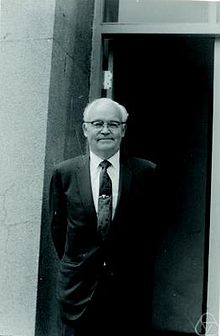Magnus Hestenes
Magnus Hestenes (born 1906 in Bricelyn , Minnesota , † May 31, 1991 ) was an American mathematician . In 1952 he and Eduard Stiefel introduced the CG method (conjugate gradient method) in numerical linear algebra .
Life
Hestenes studied at the University of Wisconsin (master's degree in 1928) and received his doctorate in 1932 under Gilbert Bliss at the University of Chicago ( Sufficient Conditions for the General Problem of Mayer with Variable End-Points ). He was then at Harvard University with Marston Morse . During World War II, he worked as a member of the Applied Mathematics group at Cornell University with air defense. After the war he was briefly an associate professor at the University of Chicago and in 1947 became a professor at the University of California, Los Angeles (UCLA), where he retired in 1973. From 1950 to 1958 he was chairman of the mathematics faculty there and from 1961 to 1963 he headed the computer center of the university. He had 34 PhD students in Chicago and Los Angeles. In the 1950s he was also on a part-time basis at the Institute of Numerical Analysis (INA) of the National Bureau of Standards at UCLA, where it came to his publication with Eduard Stiefel on the method of conjugated gradients, both of which developed the method independently before their meeting had.
In the 1960s and 1970s he was a consultant to the Institute for Defense Analyzes and the IBM Thomas J. Watson Research Center .
Hestenes was a Guggenheim Fellow (1954) and a Fulbright Fellow. In 1954 he was invited speaker at the International Congress of Mathematicians (ICM) in Amsterdam . At times he was Vice President of the American Mathematical Society .
Richard Tapia , William Karush and Glen Culler are among his PhD students .
He is the father of David Hestenes .
plant
In addition to developing the methods of conjugate gradients (he worked on similar methods in geometry as early as the 1930s), he worked on Bolza's problem in calculus of variations and optimal control theory (based on an air defense problem) and quadratic forms in Hilbert spaces (1951 ). A paper published by Rand Corporation in 1950 contained a version of Lev Pontryagin's maximum principle (from the mid-1950s).
Fonts
- Optimization theory- the finite dimensional case, Wiley 1975
- Calculus of variations and optimal control theory, Wiley 1966
- Conjugate direction methods in optimization, Springer 1980
source
- Obituary in Journal of Optimization theory and applications, Vol. 73, 1992, p. 225
- Hestenes Conjugacy and Gradients , Memoirs of Hestenes, in Stephen G. Nash (editor) A history of scientific computing , ACM Press 1990, pp. 167-179, online, pdf
literature
- Gérard Meurant The Lanczos and conjugate gradient algorithms - from theory to finite precision computations , SIAM 2006 (with biography of Hestenes)
- Gene Golub , O'Leary Some history of the conjugate gradient and Lanczos method , SIAM Review, Vol. 31, 1989, pp. 50-100
Web links
- Magnus Hestenes in the Mathematics Genealogy Project (English)
- Obituary by Tony Chan
Individual evidence
- ↑ Hestenes, Stiefel Method of conjugate gradients for solving linear systems , Journal of Research of the National Bureau of Standards, Vol. 49, 1951, pp. 409-438
- ^ Mathematics Genealogy Project
- ↑ So Hestenes in his memoirs. He showed the work to Professor Graustein , a geometer, who did not consider it to be published
- ↑ published in 1949 as an (unpublished) RAND report and presented in a book by Hestenes 1966 Calculus of variations and optimal control theory
- ^ Application of the theory of quadratic forms to the calculus of variations, Pacific Journal of Mathematics, Vol. 1, 1951, pp. 525-581
- ↑ Hans Josef Pesch Key Technology Mathematics , Teubner 2002, p. 56
| personal data | |
|---|---|
| SURNAME | Hestenes, Magnus |
| ALTERNATIVE NAMES | Hestenes, Magnus Rudolph (full name) |
| BRIEF DESCRIPTION | American mathematician |
| DATE OF BIRTH | 1906 |
| PLACE OF BIRTH | Bricelyn , Minnesota |
| DATE OF DEATH | May 31, 1991 |
